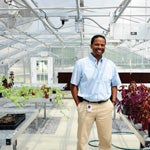
By Emily Beckett
Chilton County High School agriscience teacher Marlon Harton’s love of plants is evident in his surroundings.
Harton’s classroom at CCHS is filled with copious amounts of greenery, and he and his students are responsible for much of the landscaping around the school.
But Harton’s well-manicured, 2-acre yard at home is perhaps even more reflective of his propensity for plant growth, soil management and landscape design.
“I don’t really do it as a showcase type thing,” Harton said. “It’s kind of a means of expression to me, and I just enjoy being outside.”
Harton has taught agriscience at CCHS for 16 years, but even before teaching, he had developed an appreciation for plants and agriculture in general.
Originally from Lawrence County, Harton said he grew up on a small farm, where he helped his family raise cattle, corn and cotton.
“Through my high school and college days, I had cattle that I raised with my grandfather,” Harton said. “He just kind of allowed me that opportunity. My parents and grandparents were funding it all, but I felt like it was mine.”

Harton said his mother instilled in him a fondness for plants in relation to landscaping and gardening.
“I guess I got it honestly because my mother was a yard person, and growing up, I had to do it exactly the way she wanted it,” Harton said. “With the plants, I just took an interest in them. I enjoy seeing them grow.”
Harton majored in agriscience education at Alabama A&M University.
He lives in Clanton with his wife, Monique, and their three daughters, Lesley, Lauren Kay and Lydia.
Although Harton said his wife is not an “outside person,” Lesley frequently helps him in the yard, and all three daughters have taken an interest in topiaries because of the different shapes they can take.
Commonly made with boxwood shrubs, topiaries are shrubs or trees clipped into ornamental shapes.
“We kind of got into the topiary,” Harton said. “The girls were fascinated by a dolphin shrub at SeaWorld.”
So, Harton and his daughters have tried to make various topiaries at home, including a butterfly and a snail.
They also enjoy picking fruits including peaches, apples, blackberries and grapes together in their yard.
“I just like them having that opportunity to see the plants grow, from a seedling to a grown plant,” Harton said. “I think that’s good for a child to see that without having to look at it in a textbook or computer screen.”
In addition to the fruit-bearing trees and vines, Harton’s yard features Shumard oaks, Japanese maple, Abelia (plant in the honeysuckle family), crape myrtles, azaleas, pecan trees, Loropetalum (shrub in the witch-hazel family), Nandina (flowering plant native to Asia), Cleyera (evergreen shrubs) and variegated privet and arborvitae.
Harton averages 12–15 hours per week working in his yard, after school for about an hour each day and nearly all day Sunday.
“I do my best thinking when I’m mowing the grass and messing with plants and the soil,” Harton said. “I just enjoy amending the soils.”
Harton never has trouble finding something to do in his yard. From watering plants to mowing the grass to scouting for insects, he stays busy.
Harton said several people who have influenced him in plant growth and maintenance are Herman Washington and Stephen Blackwell, along with Chris Davis, who hired him as agriscience teacher at CCHS and encouraged him to revamp the campus with better landscaping while also giving students hands-on experience.
“Just having the opportunity to expose students to agriscience, it’s rewarding to have them understand the oldest science known to man and how it relates to their everyday life,” Harton said. “It’s very important that students understand agriscience and its many facets.”
